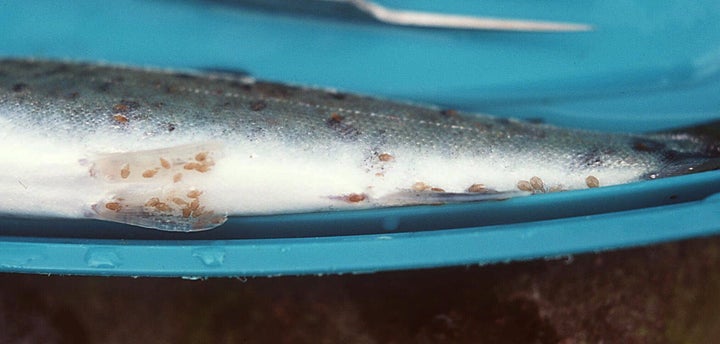
Farmed salmon present a serious threat to the survival of wild salmon stocks in the form of tiny sea lice, according a new study by Martin Krkosek of the University of Otago in New Zealand. He and his team of researchers have been studying sea lice and salmon for years, and have made headlines in the past for demonstrating the link between sea lice in farmed salmon and spillover infection of wild salmon -- and the latest study is their most unequivocal yet.
That link is much-disputed, but the stakes are high. Some have said that, if sea louse infections continue to spread, they could lead to mass extinctions among wild salmon. A fully grown salmon can survive a sea louse infection with relatively superficial injuries to gills, fins and skin. But just two or three of the critters can cause enough damage to kill a juvenile salmon. Infestations have been known to result in 80% mortality in stocks of wild juvenile salmon.
Wild salmon do naturally get sea lice. But it is rare, in the wild, for their prevalence to be high enough to cause a mass outbreak. It's only in the close quarters of aquaculture that sea lice often grow exponentially. As one paper on the topic puts it, "crowded conditions facilitate parasite and disease transmission within the farm, and enable exponential population growth of pathogens and release to the surrounding environment."
The fish farming industry has been slow to accept the idea that its activities could be harming wild salmon. But even if the industry, biologists and regulators all agree that the threat is real, it's a unclear what the solution would be.
There is a drug, Slice, that is an effective antidote to sea lice, but some believe it could be environmentally deleterious and encourage drug resistance among sea lice. (According to Krkosek, many sea lice have already developed resistance to Slice in Norway and New Brunswick.) One helpful change would be the universal adoption of closed containment systems for salmon farming, and the tapering-off of net farming. But that could drive up the price for the farmed meat and present technical challenges.
More globally, as Krkosek told the Huffington Post in an e-mail, it may be necessary to shift aquaculture away from carnivorous fish like salmon and towards vegetarian fish like tilapia. "Carnivores like salmon yield a net loss of fish supply because they require large inputs of wild fish in the feed," he said.
News stories like this, on the challenges and risks presented by, it seems, every kind of fish, can make it seem choosing sensible seafood daunting. But the Monterey Bay Aquarium Sustainability Guide, though it has its detractors, remains generally reliable. It acknowledges the difference between salmon farmed in nets, which it recommends avoiding, and those farmed in tanks, which it endorses.